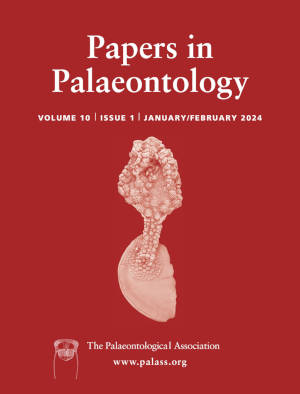Article: Earliest Danian outer neritic elasmobranch assemblages reveal an environmentally controlled faunal turnover at the Cretaceous–Palaeogene boundary in the northern Tethyan Realm (Austria)
Publication: Papers in Palaeontology
Volume:
10
Part:
1
Publication Date:
2024
Article number:
e1547
Author(s):
Iris Feichtinger, Jürgen Pollerspöck, Mathias Harzhauser, Gerald Auer, Stjepan Ćorić, Matthias Kranner, Bernhard Beaury, and Guillaume Guinot
DOI:
10.1002/spp2.1547
Abstract
Abstract This study reports elasmobranch remains from two fossil-rich horizons in the earliest Danian Olching Formation at Waidach, Austria. These outer neritic assemblages complement previous fine-scale bulk-sampling of latest Maastrichtian horizons at Waidach and document a regional elasmobranch faunal turnover across the Cretaceous–Palaeogene (K–Pg) boundary. The Danian assemblages show homogeneity in species richness and are dominated by squaliforms. The fauna comprises 16 species belonging to 12 genera including several new taxa (Centrodeania rugosa gen. et sp. nov., Centrodeania annae gen. et sp. nov., Incognitorapax fernsebneri gen. et sp. nov., Scyliorhinus alaformis sp. nov.). Comparison with latest Maastrichtian assemblages from Waidach revealed a marked faunal turnover across the K–Pg boundary associated with an increase in species richness and shift in abundance from Squaliformes to Carcharhiniformes. This is associated with marked environmental changes from a deep marine, dysoxic setting in the Maastrichtian to a more oxygenated, shallower environment in the earliest Danian. The turnover was driven by environmentally induced regional changes in species geographic ranges. High diversity in the Danian fauna suggests that the habitability of the corresponding palaeoenvironment was preserved or recovered immediately after the K–Pg event. Comparison with other elasmobranch assemblages across the K–Pg boundary highlights a strong control of local palaeoenvironmental settings over the timing and magnitude of the turnover. Our study emphasizes the importance of successive sampling to disentangle local from general patterns of faunal turnover during the K–Pg event and to better assess the consequences of this extinction event over elasmobranch diversity.
